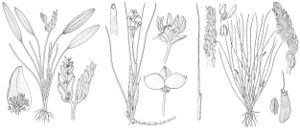Difference between revisions of "Aponogeton distachyos"
Supplementum Plantarum 32, 214. 1782 (as distachyon).
FNA>Volume Importer |
FNA>Volume Importer |
Revision as of 20:59, 16 December 2019
Leaves floating; petiole to 100 cm; blade ovate, narrowly oval, or narrowly lanceolate, 6–23 × 1.5–7.5 cm, base rounded to attenuate, apex obtuse to acute; veins 7–9. Inflorescences: spikes 1 or more, to 4.5 cm; spathe ca. 3 cm. Flowers in 2 rows, secund; tepals becoming green, enlarging, 10–15 × 3.5–6 mm, to 30 mm in fruit; veins 13 or more; stamens 3–4.5 mm; filaments expanded basally; anthers blackish purple; pollen yellow; pistils 2.5–3 × 0.7–1 mm; ovules usually 4. Fruits to 22 × 6 mm; beak 5 mm.
Phenology: Flowering late winter–spring (Mar–Apr), fall (Oct–Nov).
Habitat: Quiet ponds
Elevation: 0–550 m
Distribution

Calif., South America, Europe, Africa, Australia.
Discussion
Aponogeton distachyos is native to temperate South Africa and has become widely established in Australia. It is very popular in water gardening because it blooms during the cooler periods of the year. The plant does not do well in the heat of the summer. It flowers early in the growing season, goes dormant during the summer, and flowers again late in the season. Where the weather is mild, it will flower all winter. Presently, it is known in North America only from central-coastal and southern California.
Selected References
None.
